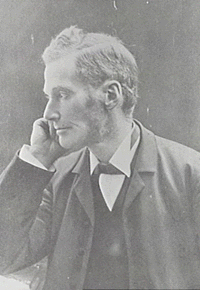John Tebbutt (1834-1916)
 John
Tebbutt (1834-1916) was a pioneer in the field of astronomy and lived his
whole life in the Hawkesbury district.
John
Tebbutt (1834-1916) was a pioneer in the field of astronomy and lived his
whole life in the Hawkesbury district.
Source : Hawkesbury City Council Library Service
John Tebbutt was a pioneer in the field of astronomy, living his whole life in the Hawkesbury district. John Tebbutt born in Windsor 25th May 1834 Windsor NSW, the son of John Tebbutt and Virginia nee Saunders. From about 1839 he was educated in Windsor by Edward Quaife, who instilled in Tebbutt a love of astronomy. He was later taught by Reverend Matthew Adam, the Presbyterian minister and Reverend Henry Stiles the Anglican minister in Windsor.
In 1853, Tebbutt bought his first instrument, a marine sextant. Several years later John Tebbutt married Jane Pendergast on the 8th September 1857 at St. Matthew's Church of England, Windsor. They had 6 daughters and 1 son.
In 1861 Tebbutt discovered the Great Comet 1861 (Comet Tebbutt II 1861) The following year, Mr W. Scott the government astronomer resigned and the position as NSW Government Astronomer was offered to Tebbutt. He however declined the position to concentrate on his own work. He joined the Philosophical (Royal) Society of NSW.
In 1863 he had constructed the first of several observatories on the family property at the Peninsula at Windsor.
He was highly regarded overseas and his observations assisted in advancing astronomy in Australia and internationally.He won a silver medal at the 1867 Paris Universal exhibition for a scientific report he had published. John Tebbutt was elected a Fellow of the Royal Astronomical Society in London in 1873 for his contribution to astronomy.
In 1879 he built a substantial brick observatory and library building at the Peninsular, the Equatorial room was built in 1894. This same year he observed the Transit of Venus.
To assist with his observations, in 1886 he purchased a Grubb 8 inch equatorial refractor. He was elected the first president of the NSW Branch of the British Astronomical Association in 1895.
For his service to astronomy in Australia he was awarded the prestigious Hannah Jackson nee Gwilt gift and bronze medal from the Royal Astronomical Society, London in 1905 and published "Astronomical Memoirs" in 1908. During his life he published 371 articles including booklets, reports and journals.
John Tebbutt died on the 29th November 1916, aged 82 years. His funeral was one of the largest ever held in Windsor. He is buried in a vault which he designed at St. Matthew's Church of England Cemetery Windsor. In honour of Tebbutt's achievements, the International Astronomical Union renamed a lunar crater on the moon in 1973.
On the 26th March 1984 Tebbutt appeared on the new $100 note. (Sir Douglas Mawson the Antarctic explorer was on the other side). This note was replaced in on the 15th January 1996.
Hawkesbury Council reprinted Astronomical Memoirs with some additional material in 1986. During the 1990s his observatory has been renovated and open as a tourist attraction, by appointment to the public.
Source : Astronomical Memoirs / John Tebbutt (1908, reprinted 1986)